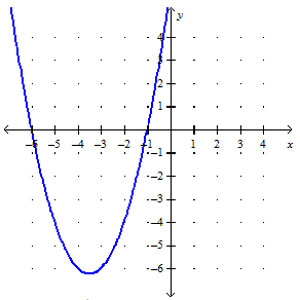
Let’s Now Begin Looking at Quadratic Inequalities
The idea of an infinite solution set applies to quadratic inequalities as well. You know from your study of quadratic equations that they can have zero, one, or two real solutions.
A quadratic inequality can have from zero to infinite solutions.
Look at the function y = x2 + 7x + 6. Two solutions occur when y = 0.
Let's begin with an equation:
Factor and solve:
x2 + 7x + 6 = 0
(x + 1)(x + 6) = 0
x +1 = 0 or x + 6 = 0
x = -1 or -6
The solutions are two x-values and are indicated by the x-intercepts on the graph – the two finite points (-1, 0) and (-6, 0).

The above equation can be rewritten as four different inequalities (four different inequality signs):
Each of these represents a slightly different solution set.